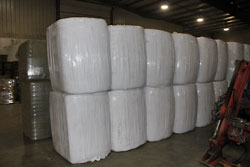
The Canadian Grain industry is heavily regulated in Canada. That means customers from overseas can always be provided with reliable, consistent product. The Canadian Grain Commission (CGC) is an agency of the federal government. It makes sure that all grain exported from Canada has been through the regulated grain handling system and has been officially certified.
Canadian grain such as oats, barley, wheat, and oil seeds are exported internationally and often travel great geographical distances. Although Canadian grain are transported in massive quantities, they are not stored in terminals. They are stored at farms that produced the grains. Then, when a certain kind of Canadian grain is wanted by an international customer, it is delivered from the farmer and moved into export position.
Canada’s Grain Handling System
Canada’s unique grain handling system guarantees quality assurance as it defines and applies quality standards on all Canadian grain. The Canadian Food Inspection Agency registers varieties of grain grown in Canada after the specific plant lines are evaluated by the CGC. To ensure all Canadian grain is reaching specific standards, the CGC uses grain grades to describe the quality of grain. These grades and standards are reviewed regularly to make sure they meet the needs of customers and the needs of Canadian grain producers like Barr-Ag Hay and Grain Exporters.
The Canadian Grain Commission is always engaged in scientific research to better understand grain quality and discover new ways to grow, handle and ship it to Canada’s international grain buyers. There are ongoing studies and research that continuously improve the grain grading system. This helps the Canadian grain export industry understand how different grains reflect quality and what can be done to make it better. The scientific research also helps growers increase harvest quality. Grain samples are gathered and analyzed from Canadian grain producers.
As the grain moves through the grain handling system from farm to export facility, it is checked that accurate weights are maintained throughout the process and that the grain itself is safe. Then when it is in the last stages of the grain handling system the grain is inspected at export to ensure that the grain meets Canada’s grain standards. Even as the grain is loaded onto the vessel at the export terminal it is being monitored to ensure the correct weight is loaded. At that point the grain is issued a Certificate Final.
“The Certificate Final is Canada’s assurance that your shipment meets Canadian quality and quantity standards. For each export cargo of grain from Canada the Canadian Grain Commission issues a Certificate Final. On this certificate, you will see the official grade and weight of the grain loaded on the vessel.” – Canadian Grain Commission
Exporting Canadian Grain – Barr-Ag Hay & Grain Exporters

Barr-AG is an exporter of Canadian Grains to countries around the globe. Canadian quality Oats, Barley, Wheat and oil seed such as flax and canola are all either produced on a Barr-AG farm or purchased and stored (from Canadian Farmers) and then exported Internationally.
Oats, barley and wheat, as well as flax, canola and peas come from our farms and/or our local network of Canadian Farm Producers who follow our growing protocols and adhere to our quality control standards. All of our grains, oil seeds and pulse crops are non-GMO. We specialize in containerizing and loading these products in 20 or 40 foot containers for international shipping and take care of the necessary customs documents.
Contact Barr-Ag for more information.
Source: http://www.grainscanada.gc.ca/index-eng.htm








